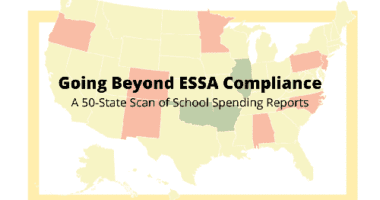There’s More Than One Way To Think About Gap-Closing on NAEP
Looking at achievement gaps that separate low-income students and students of color from their affluent and white peers isn’t only about looking at differences in scores. There’s more to gaps — and to gap-closing — than simply subtracting the performance of one group of students (like low-income students) from the performance of another (like higher income students). When looking at the scores on that National Assessment of Educational Progress (NAEP), it’s important to ask at least four questions to better understand patterns in state achievement gaps:
- Has the difference between two groups’ average scale scores changed over time? Let’s look at gap-narrowing between 2003 and 2013. In some states, like Illinois, gaps between its African American and white students, Latino and white students, and low-income and higher income students narrowed in fourth-grade reading and fourth and eighth-grade math. On the other hand, states like Washington state saw gaps widen in fourth and eighth-grade reading and math.
- Has performance improved for all groups of students over time? From 2003 to 2013, performance for all groups has been going up in states like Georgia. But in others, like South Dakota, groups are losing ground in both fourth and eighth-grade reading.
- What’s the current gap size between groups in a state? The variation across states can be huge: In eighth-grade math, for example, Wisconsin’s 43-point gap between its African American and white students is almost twice as wide as the gap in Kentucky. In eighth-grade reading, the current Latino-white gap is four-to-five times wider in Massachusetts than in states like Missouri, Ohio, and Tennessee.
- How do groups of students currently perform relative to similar students in other states? States like Mississippi and Michigan frequently perform worse than average for students of color and low-income students. But New Jersey and Maryland repeatedly show up near the top.
Two states exemplify what can happen when we look at the data from all of these perspectives at once.
Take South Carolina. The state’s gaps are about average for the nation; for better or for worse, the state doesn’t stand out. But that changes when we ask more questions about the state’s performance. Gaps between low-income and higher income students have widened since 2003, and students in South Carolina are showing stagnant or declining performance in some subjects.
On the other hand, look at Florida. Florida isn’t perfect. In some cases, the state’s NAEP performance isn’t great relative to other states. But for the most part, gaps in fourth and eighth-grade reading and math have narrowed since 2003; performance has increased for students regardless of their race/ethnicity or family income; and gaps between groups are smaller than average. And many of these improvements have been substantial.
Individually, each of these questions provides useful information; together, they provide a much richer perspective that can help us better identify states that are improving achievement and narrowing gaps across the nation.










